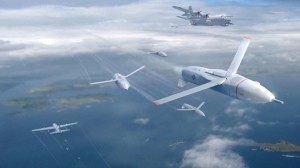
Right now, it’s fiction. A swarm of Unmanned Aerial Vehicles (UAVs) swoop down on an unsuspecting fighter, crippling its electronic and communications systems, forcing it to return to base.
UAVs are evolving at an exceptionally rapid pace, and thanks to the U.S. Defence Advanced Research Projects Agency (DARPA), they’re about to become a threat to multi-million dollar military platforms like warships and fighter jets.
The recent launch of the Agency’s “Gremlins” program provides more than enough proof of that, despite its watered-down “don’t jump to obvious conclusions” objectives.
According to DARPA’s Dan Pratt, the Gremlins program is specifically designed to “conduct a compelling proof-of-concept flight demonstration that could employ intelligence, surveillance and reconnaissance (ISR) and other modular, non-kinetic payloads in a robust, responsive and affordable manner.”
What does that actually mean? Instead of using missiles to defeat an enemy (which costs a fortune), the U.S. hopes to be able to launch a fleet of recoverable UAVs from an aircraft to wreak havoc on whatever’s on the target list.
While Pratt makes a point of telling the public that DARPA’s Gremlins will carry “non-kinetic” payloads for ISR missions, once the technology is proven, it won’t be long before the United States and partner defence companies find a way to weaponize them (Oh wait, they already have).
But let’s not get too far ahead of ourselves. Right now, DARPA’s focus is on “the technical challenges associated with safe, reliable aerial launch and recovery of multiple unmanned air vehicles.”
The Agency hopes to be able to launch and recover UAVs in the air, and then quickly prepare them for their next mission within the span of 24 hours. With an expected lifetime of 20 uses, Pratt says the Gremlins could fill “an advantageous design-and-use space between existing models of missiles and conventional aircraft.”
If DARPA can prove that the technology is cost effective, expect fewer missiles, and more Gremlins in the air.
Imagine twenty UAVs launched from an aircraft, all with explosive payloads, bearing down on a warship. Inundated with multiple targets, the UAVs don’t need to sink the ship, just put it out of commission before returning to the aircraft from whence they came.
It sounds terrifying. But for every new weapon created, expect an equal amount of time and effort dedicated to finding a way to combat it. The U.S. Navy, in fact, is already working on a plan to slay swarms of UAVs… by fighting them with its own swarms of UAVs, launched out of something resembling a cannon (a “tube-based” launcher).
Defenseone.com reports that, once operational, “The U.S. Navy will launch up to 30 synchronized drones within one minute…”